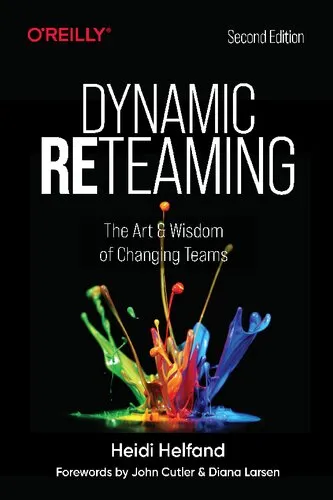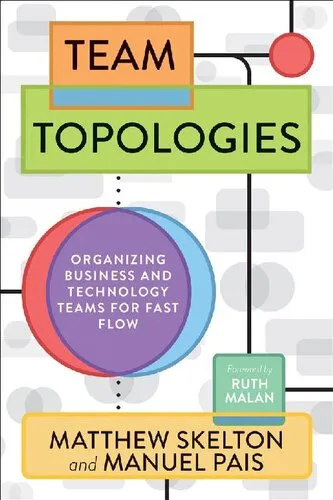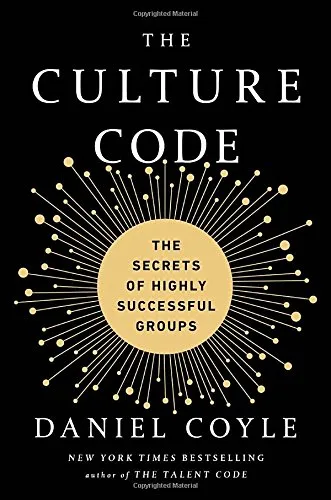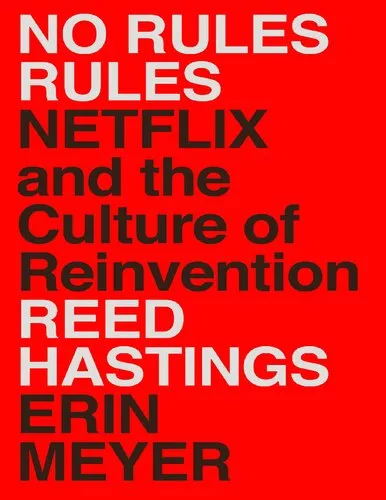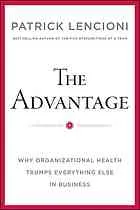Dynamic Reteaming (2020) [Helfand
5.0
بر اساس نظر کاربران

شما میتونید سوالاتتون در باره کتاب رو از هوش مصنوعیش بعد از ورود بپرسید
هر دانلود یا پرسش از هوش مصنوعی 2 امتیاز لازم دارد، برای بدست آوردن امتیاز رایگان، به صفحه ی راهنمای امتیازات سر بزنید و یک سری کار ارزشمند انجام بدینکتاب های مرتبط:
Persian Summary
مقدمهای بر کتاب 'Dynamic Reteaming (2020)' اثر Helfand
کتاب 'Dynamic Reteaming' اثری جامع و مفهومی درباره تعاملات تیمی در دنیای پیچیده نرمافزار و فناوری است. این کتاب با رویکردی فراتر از ساختارهای ثابت تیمی به بررسی موضوعات پویایی تیمها و چگونگی تاثیر تغییرات در ترکیب تیمها بر بهرهوری و نوآوری میپردازد.
خلاصهای از کتاب
در 'Dynamic Reteaming'، Helfand بر پویایی و ارتباطات درونی تیمها و اهمیت آنها در دستیابی به اهداف بزرگتر تاکید میکند. نویسنده بهجای تاکید بر ثبات، نقطه تمرکزش را بر توانایی تیمها در سازگاری و تغییر بر اساس نیازهای متغیر سازمانی و تکنولوژیکی قرار میدهد. او از تجربیات واقعی استفاده میکند تا نشان دهد چگونه تیمها میتوانند با موفقیت در زمانهای تغییر و تحول خود را بازسازی کنند.
کتاب با معرفی مفهومی از Reteaming شروع میشود و سپس به تشریح مدلهای مختلفی از تغییرات تیمی و راهکارهای عملی برای مدیریت این تغییرات میپردازد. Helfand از داستانهای واقعی صنعت نرمافزار و تحقیقات خود بهره میبرد تا نشان دهد که پویایی و تحول در تیمها نه تنها امکانپذیر بلکه ضروری است.
نکات کلیدی
- پویایی تیم (Dynamic Reteaming) به عنوان یک ضرورت برای رشد و نوآوری سازمانی.
- مبانی و اصول بنیادین Reteaming برای بهبود سازگاری تیمها.
- ارائه راهکارهای عملی برای مدیریت و اجرای تغییرات مؤثر در تیمها.
- مطالعه موردی از تجربیات واقعی صنعت برای درک بهتر مفاهیم و استراتژیها.
جملات معروف
«در دنیای سریع و بیثبات امروز، توانایی برای تغییر و تحول یکی از ارزشمندترین ویژگیهای یک تیم است.»
«ثبات در تیمها لزوماً به موفقیت منجر نمیشود، بلکه توانایی در پذیرش تغییرات و سازگاری با آنها عامل اصلی پیشرفت است.»
چرا این کتاب مهم است
در این کتاب، Helfand نگاهی نو و متفاوت به چالشهای تیمی در سازمانهای مدرن دارد. در زمانی که بسیاری از سازمانها بر تثبیت ساختارهای خود تمرکز کردهاند، 'Dynamic Reteaming' نوری تازه بر اهمیت انعطافپذیری و پویایی در ساختار تیمها میتاباند.
با ارائه مثالهای عملی و راهبردهای واقعی، این کتاب به متخصصان و مدیران کمک میکند تا تیمهای خود را برای تغییرات آینده آماده کنند. بدین ترتیب، سازمانها میتوانند نه تنها در برابر تحولات پایدار بمانند بلکه در محیطهای بیثبات و رقابتی نیز مانند گذشته بهتر عمل کنند.
این کتاب برای تمامی کسانی که در صنعت فناوری فعالیت میکنند و یا علاقهمند به فهم عمیقتر پویایی و سازگاری تیمها هستند، منبعی ارزشمند و بینظیر به شمار میآید.
Welcome to "Dynamic Reteaming: The Art and Wisdom of Changing Teams" by Heidi Helfand, an influential piece of literature in the realm of software development and organizational management. This book explores the dynamics of team restructuring and how these changes can lead to superior performance and innovation within organizations. Whether you're a team leader, project manager, or a member of a software development team, this book offers invaluable insights that can reshape your approach to teamwork.
Summary of the Book
"Dynamic Reteaming" delves into the concept of team changes—deliberate or unplanned—and how they can positively impact an organization's health. Contrary to the traditional belief that stable teams are the most productive, Helfand presents a compelling argument for the strategic reteaming of groups. The book details various patterns of changing teams, from one-by-one changes to mass reshuffles within the workforce. These patterns are supported by real-life case studies from notable tech companies that have successfully navigated team dynamics to foster growth and adaptability.
The book is structured around several key principles, each representing a facet of organizational agility through re-teaming. Helfand provides a roadmap for leaders looking to implement these changes, emphasizing the importance of flexibility, employee engagement, and the benefits of diversity brought about by new team compositions. It also highlights the emotional aspects of team changes, providing strategies to mitigate negative impacts on morale and performance.
Key Takeaways
- Embrace Change: Understand that team changes are inevitable and can be leveraged for competitive advantage.
- Team Patterns: Learn about the different patterns of reteaming and how they can be applied in various contexts.
- Humans First: Address the human element of change by fostering an environment of trust and empathy.
- Leadership Role: Discover how leaders can manage reteaming processes to ensure smooth transitions and maintain productivity.
- Diversity as Strength: Recognize the enhanced creativity and problem-solving capability brought about by diverse teams.
Famous Quotes from the Book
"Teams are dynamic systems—when you embrace that, you can own change and master its flow."
"Reteaming is a powerful idea, much like retelling a story; it’s about change and renewal."
Why This Book Matters
In the fast-paced world of tech and agile development, "Dynamic Reteaming" stands out as a crucial text for understanding how team dynamics influence business outcomes. The traditional concept of forming a team and keeping it intact for as long as possible has seen its challenges in today's world. Helfand's work provides a new paradigm, where team changes are not just managed but leveraged for ultimate organizational benefit.
With its practical advice and case studies, the book is a must-read for anyone looking to harness the power of team dynamics. The strategies offered are not only applicable to software teams but are relevant across any industry where collaboration and teamwork are essential. The book provides leaders with the tools to facilitate smoother transitions, promote emotional intelligence, and maintain high performance even amid structural changes.
In an era of constant change and disruption, "Dynamic Reteaming" offers a fresh perspective, making it an essential addition to every leader's library. It equips organizations with the knowledge to navigate transitions deftly and turn potential disruptions into opportunities for innovation and growth.
دانلود رایگان مستقیم
شما میتونید سوالاتتون در باره کتاب رو از هوش مصنوعیش بعد از ورود بپرسید
دسترسی به کتابها از طریق پلتفرمهای قانونی و کتابخانههای عمومی نه تنها از حقوق نویسندگان و ناشران حمایت میکند، بلکه به پایداری فرهنگ کتابخوانی نیز کمک میرساند. پیش از دانلود، لحظهای به بررسی این گزینهها فکر کنید.
این کتاب رو در پلتفرم های دیگه ببینید
WorldCat به شما کمک میکنه تا کتاب ها رو در کتابخانه های سراسر دنیا پیدا کنید
امتیازها، نظرات تخصصی و صحبت ها درباره کتاب را در Goodreads ببینید
کتابهای کمیاب یا دست دوم را در AbeBooks پیدا کنید و بخرید
سوالات پرسیده شده از این کتاب
1635
بازدید5.0
امتیاز51
نظر98%
رضایتنظرات:
5.0
بر اساس 1 نظر کاربران
"کیفیت چاپ عالی بود، خیلی راضیام"
merkousha2
6 ژون 2024، ساعت 13:02
"Dynamic Reteaming: A Field Guide to Multi-Team Organizing" is an insightful and practical resource for anyone involved in team management or organizational development. The book offers a fresh perspective on the benefits of reteaming and provides actionable strategies to implement it effectively. Through real-world examples and expert advice, the author illustrates how dynamic reteaming can foster innovation, agility, and resilience within teams. It's a must-read for leaders looking to optimize team performance and adaptability in a rapidly changing business environment.
Questions & Answers
Ask questions about this book or help others by answering
No questions yet. Be the first to ask!
